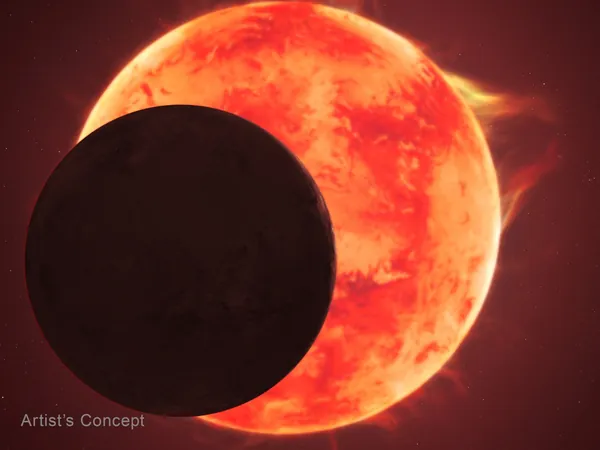
Unveiling the Mysteries of TRAPPIST-1 d: A Red Dwarf Planet's Habitability in Question
2025-08-20
Author: Nur
Are Red Dwarf Planets Capable of Supporting Life?
Scientists have long speculated about a nearby planet that could mirror Earth’s conditions. Once a leading candidate for habitability due to its rocky surface and size, TRAPPIST-1 d has recently come under scrutiny, revealing that it lacks an atmosphere akin to ours.
Webb Telescope Sheds Light on TRAPPIST-1 d
NASA's groundbreaking James Webb Space Telescope has provided fresh insights into TRAPPIST-1 d, a planet located about 40 light-years away. Caroline Piaulet-Ghorayeb, a researcher from the University of Chicago and IREx at Université de Montréal, insists this info plays a crucial role in understanding extraterrestrial environments.
"We want to determine if Earth-like environments can thrive elsewhere," says Piaulet-Ghorayeb, emphasizing that TRAPPIST-1 d has now been ruled out as a potential Earth-like twin.
What Made TRAPPIST-1 d Appealing?
The TRAPPIST-1 system, first hailed in 2017 for featuring seven Earth-sized rocky planets, is unique. Its red dwarf star is smaller and cooler than our Sun, pushing its habitable zone closer to the star. TRAPPIST-1 d, the third planet, sits at a mere 2% of the Earth-Sun distance, completing an orbit in just four Earth days. Initially, its positioning raised hopes for the presence of liquid water.
The Atmosphere Mystery
However, the Webb telescope's analysis revealed no signs of essential atmospheric components such as water vapor, methane, or carbon dioxide. Piaulet-Ghorayeb notes that the absence of an atmosphere could be due to several reasons: it might be incredibly thin, obscured by thick clouds, or the planet could simply be a barren rock.
Red Dwarfs and Their Impact
Planetary atmospheres may struggle to survive near red dwarfs due to their aggressive stellar flares. These powerful bursts of radiation often strip planets of their atmospheres, particularly those in close orbits like TRAPPIST-1 d.
Yet, the quest for understanding continues. Red dwarfs constitute the most prevalent type of star in our galaxy, and a planet retaining its atmosphere could offer valuable insights into the conditions needed for life.
Hope for Other TRAPPIST-1 Planets?
While TRAPPIST-1 d hasn’t lived up to expectations, the other planets in this system — e, f, g, and h — are still under investigation. Situated further from their star’s radiation, these planets may have a better chance of possessing an atmosphere.
"Although planet d didn’t show strong atmospheric signatures, the outer TRAPPIST-1 planets could still harbor a wealth of water and atmospheric elements," Piaulet-Ghorayeb reveals.
Paving the Way for Future Discoveries
NASA aims to use this research to explore the likelihood of life beyond Earth. Shawn Domagal-Goldman, acting director of NASA's Astrophysics Division, emphasizes the significance of understanding atmosphere retention on potentially habitable planets.
This foundational research positions NASA for future explorations, such as the Habitable Worlds Observatory, to address the age-old question: Are we alone in the universe? TRAPPIST-1 d may not be our Earth twin, but it’s a valuable stepping stone in the ongoing quest for extraterrestrial life.





 Brasil (PT)
Brasil (PT)
 Canada (EN)
Canada (EN)
 Chile (ES)
Chile (ES)
 Česko (CS)
Česko (CS)
 대한민국 (KO)
대한민국 (KO)
 España (ES)
España (ES)
 France (FR)
France (FR)
 Hong Kong (EN)
Hong Kong (EN)
 Italia (IT)
Italia (IT)
 日本 (JA)
日本 (JA)
 Magyarország (HU)
Magyarország (HU)
 Norge (NO)
Norge (NO)
 Polska (PL)
Polska (PL)
 Schweiz (DE)
Schweiz (DE)
 Singapore (EN)
Singapore (EN)
 Sverige (SV)
Sverige (SV)
 Suomi (FI)
Suomi (FI)
 Türkiye (TR)
Türkiye (TR)
 الإمارات العربية المتحدة (AR)
الإمارات العربية المتحدة (AR)